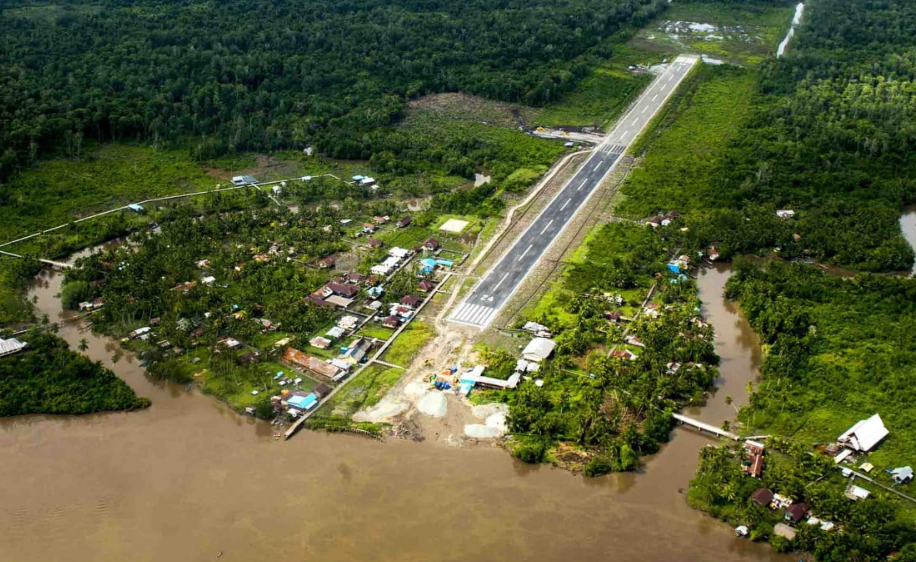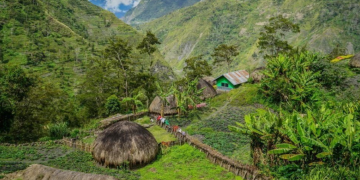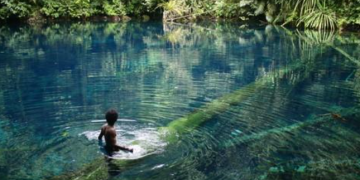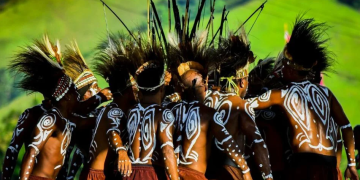PapuaAround.com – Agats, the capital of Asmat Regency in Papua, is one of the most unique areas in Indonesia. This small town, built on swamps, presents its own challenges for its residents. However, behind all these difficulties, the people of Agats demonstrate remarkable resilience to continue developing and preserving their cultural heritage.
One of the Agats’ defining characteristics is its location on swampy land. The city is constructed with wooden structures spanning over mud and water, making it resemble the “Venice of the East.” The streets in Agats aren’t made of asphalt but of ironwood planks that are resistant to humidity and weather. This system allows residents to go about their daily activities without wading through deep mud during the rainy season.
Daily life in Agats may appear challenging, but the local community has adapted and even learned to utilize their environment. A resident, John Asang, noted that the wooden planks symbolize the strong identity of the people. “This is our home; this is how we live. We respect nature and adapt to it, rather than fight against it,” John said.
A Culture That Remains Preserved
Despite Agats’ geographically isolated location, the town serves as a significant cultural center for the Asmat people, one of the largest indigenous groups in Papua. The Asmat tribe is renowned for their woodcarving art, which has gained international recognition. Each wood carving is not merely decorative but holds deep spiritual and cultural meanings.
“Our culture is our soul,” said a local artist, Frans Tefu. “We carve not just to make money, but to tell our history, about our ancestors, and about the nature around us. We take pride in preserving this tradition and sharing it with the outside world.”
Through various festivals and exhibitions, Asmat wood art has successfully attracted tourists and collectors from different countries. This has helped boost the local economy and foster hope that their cultural heritage will continue to be appreciated and preserved.
A Growing Tourism Industry
With its exotic natural beauty and unique culture, Agats is starting to attract the attention of tourists. Visitors are usually drawn to witness firsthand the life of the Asmat people, observe their woodcarving art, and enjoy the atmosphere of a town built on swamps.
Ecotourism programs in Agats are also on the rise. Local government and various non-governmental organizations are working together to improve facilities and infrastructure so that more tourists can experience the region’s natural beauty and culture. “We want Agats to become a sustainable tourist destination that everyone can enjoy, without harming our environment or culture,” said Asmat Regent Elisa Kambu.
The construction of a new dock and the improvement of transportation routes have become local government priorities to facilitate easier access for tourists to Agats. Although situated in a remote area, Agats is now more accessible through water and air transportation.
Read also: Exploring the Riches of Papuan Music, Artworks That Captivate the Soul!
Advancements in Education and Health
In addition to promoting tourism, the local government is focusing on improving the quality of education and healthcare in Agats. Schools in Agats have received support from the central government as well as from non-governmental organizations, both in terms of facilities and teacher training.
“We realize that education is the key to the future. Therefore, we are striving to provide better access to education for children in Agats,” said Maria Rumbewas, Head of the Asmat Regency Education Office.
In the healthcare sector, various preventive health programs and outreach efforts are actively conducted, especially in addressing malnutrition and diseases that frequently affect the region. Health posts in villages around Agats play a crucial role in providing medical services to communities in remote areas.
A Bright Future for Agats
Although Agats still faces several challenges, such as limited transportation access and infrastructure constraints, the local community’s spirit to keep moving forward remains unwavering. The local government, in collaboration with the central government, continues to work on developing adequate infrastructure and strengthening the local economy.
Agats is not only geographically unique but also a symbol of the determination and resilience of the Papuan people in preserving their culture and building a better future. With its growing tourism potential and attention to education and healthcare, Agats has the potential to become an example of how a remote area can thrive through its cultural heritage and human resources.
“We hope that with all these efforts, Agats will be more widely recognized and become a source of pride for Papua and Indonesia,” Elisa Kambu stated optimistically.
The portrait of life in Agats is a testament that with perseverance, solidarity, and love for culture, a community can continue to progress even in a challenging environment.







